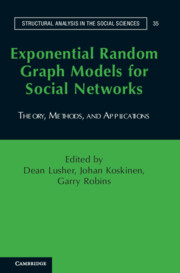Book contents
- Frontmatter
- Contents
- List of Figures
- List of Tables
- 1 Introduction
- Section I Rationale
- Section II Methods
- Section III Applications
- 14 Personal Attitudes, Perceived Attitudes, and Social Structures: A Social Selection Model
- 15 How To Close a Hole: Exploring Alternative Closure Mechanisms in Interorganizational Networks
- 16 Interdependencies between Working Relations: Multivariate ERGMs for Advice and Satisfaction
- 17 Brain, Brawn, or Optimism? Structure and Correlates of Emergent Military Leadership
- 18 Autologistic Actor Attribute Model Analysis of Unemployment: Dual Importance of Who You Know and Where You Live
- 19 Longitudinal Changes in Face-to-Face and Text Message–Mediated Friendship Networks
- Chapter 20 Differential Impact of Directors’ Social and Financial Capital on Corporate Interlock Formation
- 21 Comparing Networks: Structural Correspondence between Behavioral and Recall Networks
- Section IV Future
- References
- Index
- Name Index
15 - How To Close a Hole: Exploring Alternative Closure Mechanisms in Interorganizational Networks
Published online by Cambridge University Press: 05 April 2013
- Frontmatter
- Contents
- List of Figures
- List of Tables
- 1 Introduction
- Section I Rationale
- Section II Methods
- Section III Applications
- 14 Personal Attitudes, Perceived Attitudes, and Social Structures: A Social Selection Model
- 15 How To Close a Hole: Exploring Alternative Closure Mechanisms in Interorganizational Networks
- 16 Interdependencies between Working Relations: Multivariate ERGMs for Advice and Satisfaction
- 17 Brain, Brawn, or Optimism? Structure and Correlates of Emergent Military Leadership
- 18 Autologistic Actor Attribute Model Analysis of Unemployment: Dual Importance of Who You Know and Where You Live
- 19 Longitudinal Changes in Face-to-Face and Text Message–Mediated Friendship Networks
- Chapter 20 Differential Impact of Directors’ Social and Financial Capital on Corporate Interlock Formation
- 21 Comparing Networks: Structural Correspondence between Behavioral and Recall Networks
- Section IV Future
- References
- Index
- Name Index
Summary
Mechanisms of Network Closure
One way to think about social networks is as social structures built from the bottom up through combinations of simpler components defined in terms of local configurations of ties, or “motifs” (Milo et al., 2002; Pattison & Robins, 2002). Local configurations of network ties may be interpreted as observable outcomes of specific social mechanisms such as reciprocity. Because organizations display a strong tendency toward forming ties with their partner's partners, processes of tie maintenance and formation based on closure mechanisms have been of particular interest to scholars of interorganizational networks (Gulati & Gargiulo, 1999; Hallen, 2008; Laumann & Marsden, 1982; Lomi & Pattison, 2006). Closure has been found to shape the formation and maintenance of network ties between organizations operating in a variety of empirical settings ranging from manufacturing relations in the automotive industry (Lomi & Pattison, 2006), to strategic alliances in various industrial sectors (Gulati & Gargiulo, 1999), to equity relations between organizations belonging to the same “keiretsu” (Lincoln, Gerlach, & Ahmadjian, 1996). The accumulation of empirical experiences in the study of interorganizational relations has given shape to the general expectation that partners of partners are (more likely to be) partners. What social mechanisms may be underlying such expectations?
In theoretical terms, the tendency toward transitive closure in interorganizational networks has been framed and interpreted as the direct consequence of the costs and risks inherent in the formation and maintenance of network ties with partners whose quality, capability, and trustworthiness are only imperfectly observable (Baum et al., 2005; Sorenson & Stuart, 2008). To manage these different sources of uncertainty and reduce the exposure to opportunistic behavior of potential partners, organizations tend to form new ties with their partners’ partners based on referrals and shared information (Baker, 1990; Uzzi, 1996). Ties to common third parties also promote adherence to norms by promoting trust and by facilitating social monitoring and sanctioning of opportunistic behavior (Burt & Knez, 1995; Rousseau et al., 1998). In fact, fundamental third-party effects such as reputation and status affect the formation of network ties precisely because direct information about the quality of potential partners is not easily available (Gulati & Gargiulo, 1999; Podolny, 2001). As Coleman succinctly put it: “reputation cannot arise in an open structure” (1988, S107).
- Type
- Chapter
- Information
- Exponential Random Graph Models for Social NetworksTheory, Methods, and Applications, pp. 202 - 212Publisher: Cambridge University PressPrint publication year: 2012
- 3
- Cited by



